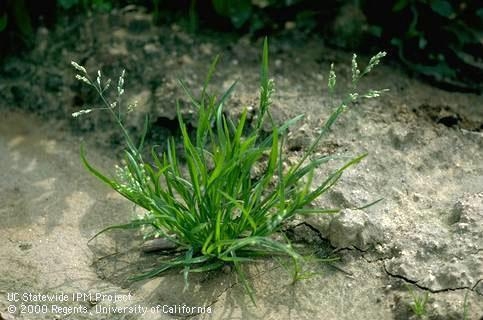
Annual bluegrass is probably one of the most common weeds in the United States in home gardens and landscapes. It grows during the cooler parts of the year and then comes into flowering in spring. You can identify annual bluegrass generally by the boat shaped tip of the leaf blade. Contrary to the name, there are actually two types of Annual Bluegrass, one is truly an annual in that it grows, seeds and dies in one season and the other is actually a perennial growing from year to year. The perennial type tend to be more of a problem on golf course greens and annual is more common in the home landscapes though it can be found in either. It tends to be a big problem in lawns because finding selective herbicides to control grasses in a grass lawn is difficult. It also tends to be very competitive in warm season lawns that are dormant in the winter since there is nothing to compete with its growth. Because annual bluegrasses are prolific seed producers, it can be a problem that can, in just a few short seasons become intense.
The best way to manage bluegrass is to prevent it from starting in the first place…easier said than done actually. If you don’t have the weed or if you just see a few plants, don’t allow them to go to seed. Just hand pulling or hoeing to remove weeds before seeding will prevent a major headache from forming.
Once you do have an infestation, there isn’t any one single control method has been successful in controlling annual bluegrass in turfgrass. Maintaining a competitive lawn is the best management practice and for tips on that go to our UC Guide to Healthy Turf at: http://www.ipm.ucdavis.edu/TOOLS/TURF/
You can use pre-emergent herbicides to limit seed germination and it should be applied a few weeks before the weed seeds germinate in late summer or early fall when soil temperatures drop below 70F. Once, however, the infestation is present, it will be difficult to manage and in some cases, a complete turfgrass renovation may be required.
In ornamental landscapes and flower beds, the best defense is a heavy mulch layer 2-3 inches thick or using landscape fabric as a weed block will do the trick. You have to maintain that mulch thickness throughout the season since weed germination can occur almost any time through the cool part of the growing season. In addition, pre-emergent herbicides for landscapes will also be somewhat effect and include materials like oryzalin, pendimethalin or combination products to limit seedling germination.
For more detailed information on managing your annual bluegrass infestation go to our IPM website and look up our pest note on Annual bluegrass at: http://www.ipm.ucdavis.edu/PMG/PESTNOTES/pn7464.html